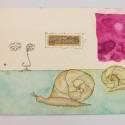
Mariana Correia Street, in the neighbourhood of Jardim Paulistano in São Paulo, is unknown even by those who inhabit its surroundings. However, it is the address of a discreet, simple house that hides an unexplored treasure of the recent artistic culture: the Fernando Zarif Project.
Almost imperceptible to those who pass the street, the house’s design surprises the visitors as soon as they enter its living room. Besides the drawings that consolidated Zarif as an artist covering the walls, the visitor is attracted to a huge wooden cross standing out in the living room floor and a stand covered with gold leaves and a hot water bag hanging under it. “This was on top of the fireplace,” explains Ivan Zarif, brother of the deceased artist, about the latter piece.
Fernando Zarif was more than an artist, he was a character. His nocturnal style of life, strong personality, eccentric clothes and passion for dry martini made him an icon of the arts and culture of the 80’s. “The clothes have always been a feature. When we were young, he wore designer clothes, always stylish ones, he looked a little phony”, recalls sister in law Margie Adriana Zarif, saying that Fernando would actually later on criticize his own clothes. Later, Zarif began to swap between black and white clothes, as he did until the end of his life.
His death in 2010 took him away from friends and family, but left a whole world to be explored. Along his life, he lived up to the reputation of a multimedia artist: with an array of works that range from drawings to covers of music albums, theatre plays and sculptures, Zarif left around 4000 works (although the number is still inaccurate) and more than 90% of his intense production is completely unknown to the public. The reasons are many. “He’s always been very reserved about showing his work. We, his family, sometimes were under the impression that he was doing nothing. He never showed any of his work and had a complicated relationship with galleries. After his passing, we found some writing pieces in which he revealed his fear of not being known”, explains Ivan Zarif. 
In order to explore, catalogue and bring out to the public what the artist hid all his life, his family, in collaboration with experts, developed the Fernando Zarif Project: installed in his house, the project aims to catalogue his work and has promoted events and lectures since 2010.
“One cannot say that Zarif was out of context”, discusses Margot Crescenti, one of the project coordinators. “The fact that he was reluctant to show his work, consequently excluding himself from the art market, meant that he had more creative freedom, which enabled him to reach further than many of his contemporaries. Still, his drawings are strongly influenced by artists of his generation, such as Tunga,” she concludes.
The project, which can be visited by appointment, as well as the exhibit Antes de Começar Termino, held at Luciana Brito last October, are initiatives that have sought to make Zarif’s work as well-known as his public persona.

Deixe um comentário